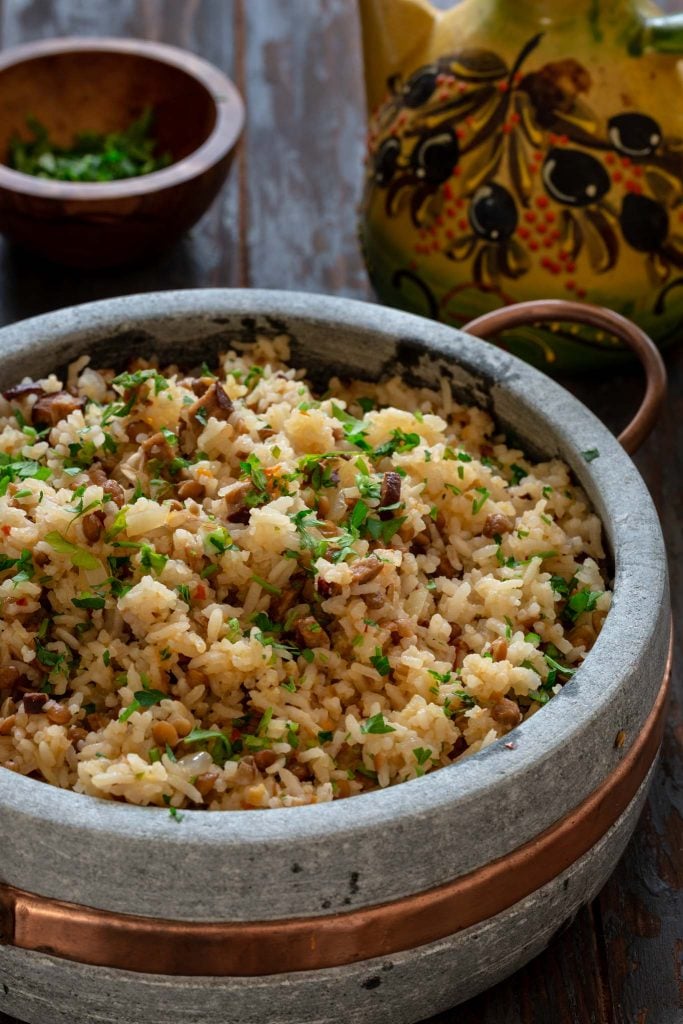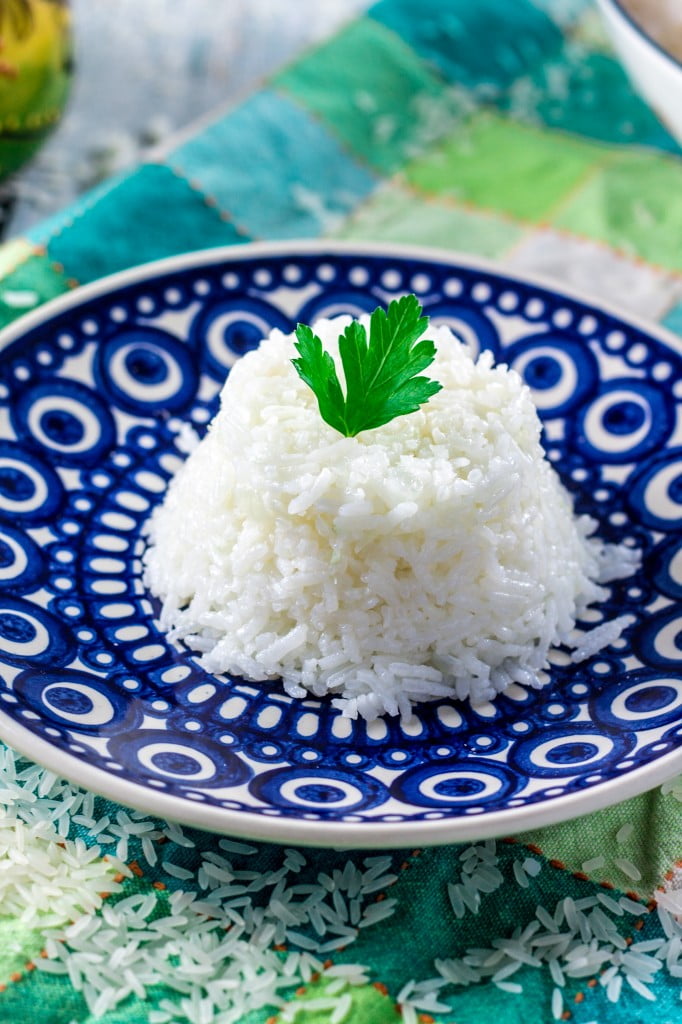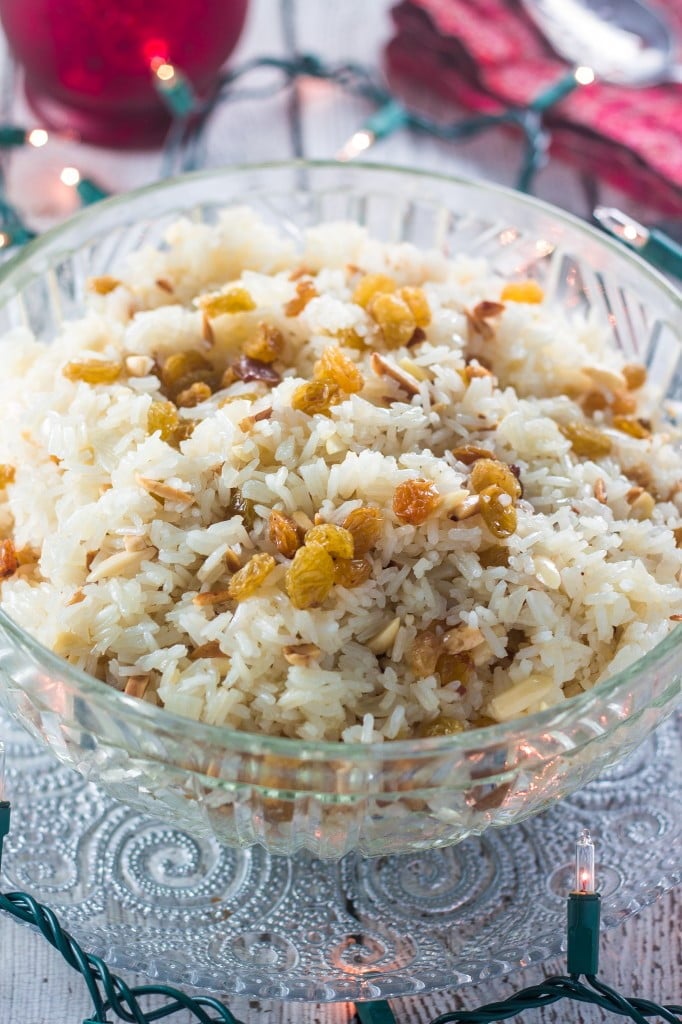Arroz a Grega (Brazilian Greek Rice Pilaf)
Arroz à Grega is a Brazilian Greek Rice Pilaf that is not really Greek! 😂😂😂 Despite the interesting (and somewhat misleading) name, it is a delicious, colorful and festive side dish that will bring joy to your holiday table.
(This post is sponsored by Carolina® Rice. All opinions are my own.)
We Brazilians love our rice! From simple Brazilian white rice to an indulgent Creamy Rice Casserole, you will find lots of rice recipes here on the blog that are not only delicious but very easy to make.
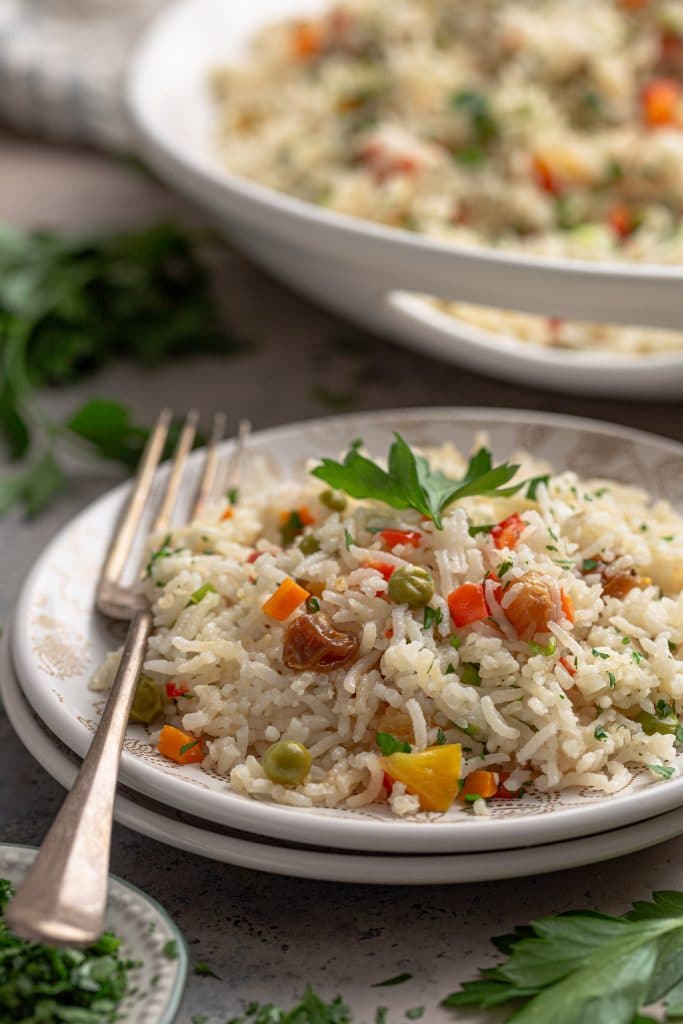
An authentic Brazilian side dish!
If you’re invited to celebrate the holidays with a Brazilian, chances are you will be served a feast!
A big, beautiful turkey (we eat turkey for Christmas, since there is no Thanksgiving), farofa, and a big platter of rice pilaf, usually Arroz à Grega.
This side dish is the subject of a lot of controversy in Brazil. At least in my family, there is always a big (friendly) argument over the raisins.
Some people claim that raisins have no business being in savory dishes, while others love the sweet and salty combination!
Well, as you’ll quickly discover, I belong to the latter group and my Arroz à Grega does have raisins. That being said, if you belong to the raisins haters group, that is okay too and you can just omit them.
However you choose to make it, I hope this colorful side dish makes your holiday table this year!
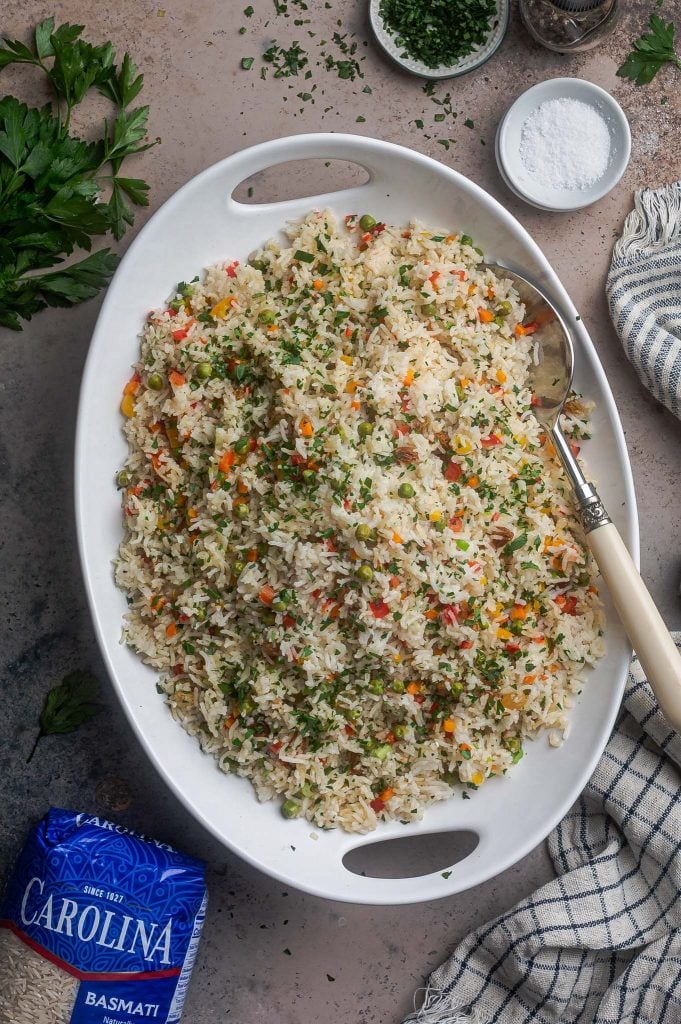
What is Arroz a Grega? Is it really Greek?
Despite its name, Arroz á Grega – which translates to Greek-Style Rice – is not really Greek.
It is a popular Brazilian side dish, consisting of rice, finely diced veggies, peas and raisins. It is often served during the holidays.
As for its origins and the reason behind the name, we’ll have to stick to our imaginations, as nobody knows! Trust me, I did spend quite some time researching it.
It could be something as simple (and completely unrelated to Greece) as it being a dish created by someone who’s nickname was “Grega”. Or perhaps a Brazilianized variation of a true Greek rice pilaf, which usually consists of rice, lemon and herbs.
But, as they say, it does not matter where it comes from, but where it is going. And, hopefully, the answer to that is: your belly!
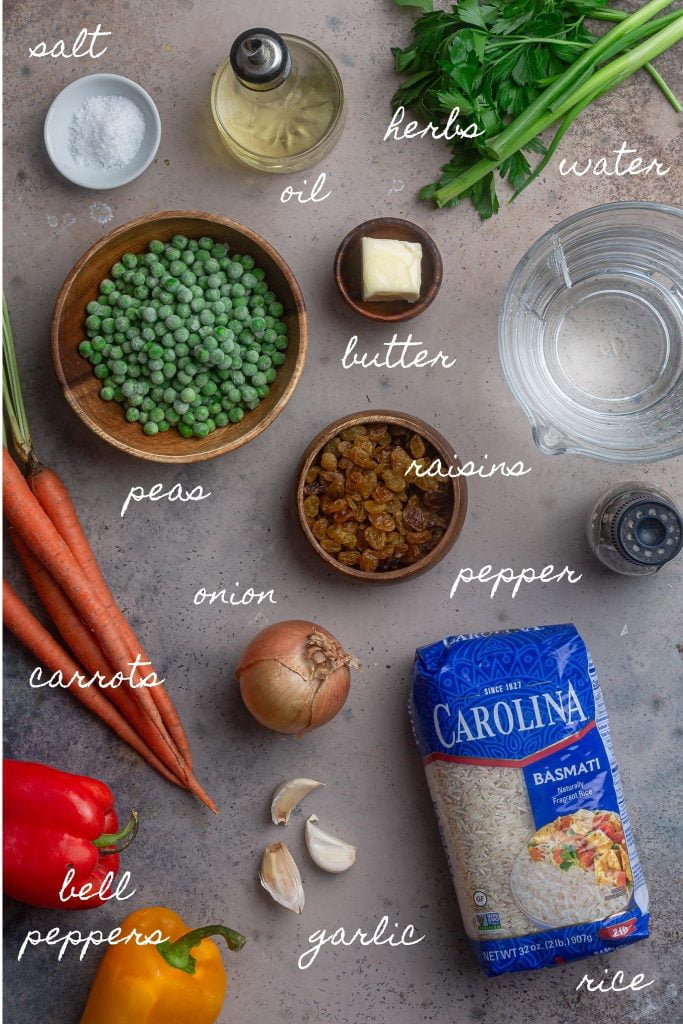
Ingredients
Here’s what you’ll need to make Arroz à Grega:
RICE – I use Carolina Basmati Rice to make this recipe.
ONION AND GARLIC – A must when cooking Brazilian food!
VEGETABLES – I use carrots and bell peppers. However, this dish is great to use whatever is sitting in your fridge, so feel free to get creative.
PEAS – I like the convenience of using frozen peans. No need to defrost either! Just add them frozen and they thaw super quick!
RAISINS – Authentic Arroz a Grega always has raisins, but – if you’re not a lover – there is no AAG police coming for you if you omit them!
OIL – I recommend a neutral-tasting oil, like vegetable or canola oil, so as to not overpower the other flavors in the dish.
BUTTER – While I don’t add butter to my regular Brazilian rice, I do think it’s a great addition here, as it gives more flavors to the veggies!
SALT AND PEPPER – Be generous with the seasoning! Nobody likes bland rice. Also, you must season before cooking, as the grains will pick up the flavor of the water.
BAY LEAF – This is optional, but I always like to add a bay leaf when I cook rice!
FRESH HERBS – Finely chopped fresh parsley and green onions. Or, like we Brazilians call it, “cheiro verde”!
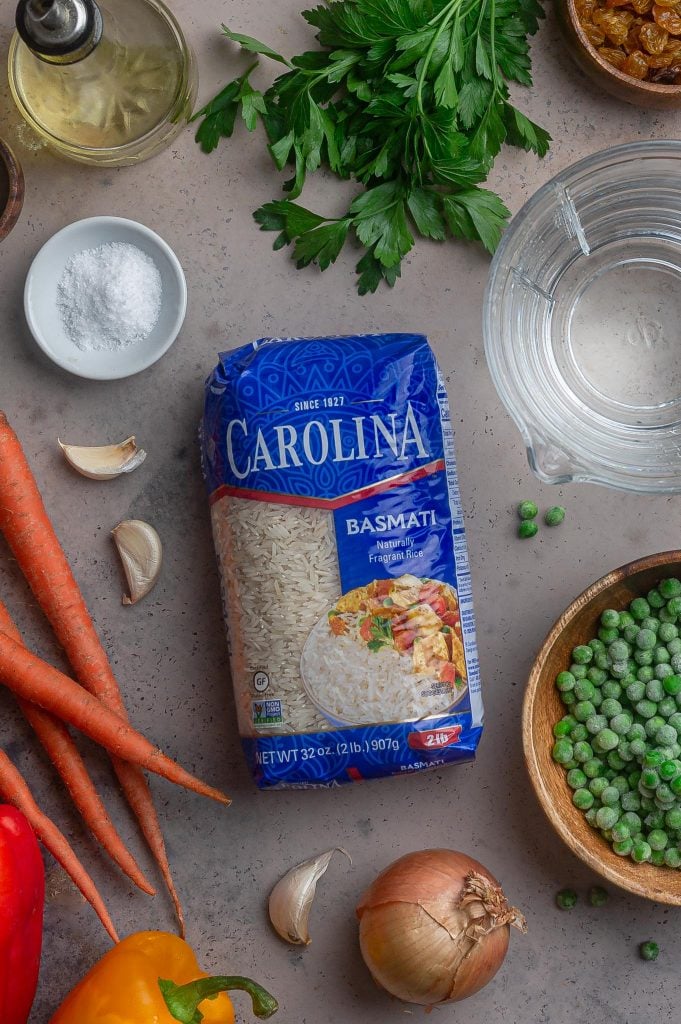
Which type of rice is best for rice pilaf?
Rice Pilaf is usually made with long-grain white rice.
In Brazil, we like using what we call “arroz agulhinha“, which cooks fluffy and produces separated tender (but not sticky) grains.
Here in the U.S., I find that the varieties that come closer to that are Jasmine or Basmati Rice. In my opinion, basmati cooks slightly looser than jasmine, so that’s what I usually use for my Brazilian recipes!
It is worth noting that the quality of rice will vary considerably depending on which brand you buy.
I might sound biased, since I am their ambassador, but Carolina® Rice truly is the best rice brand here in the United States and the quality of their rice can’t be beat!
Their extra-long and thin Basmati Rice not only tastes amazingly fragrant, but it gives off less starch while cooking, making it perfect for making Arroz à Grega and other Brazilian rice dishes!
That being said, you can also use jasmine or generic white long grain rice. Brown rice works too, but you’ll have to use more water and cooking times will change!
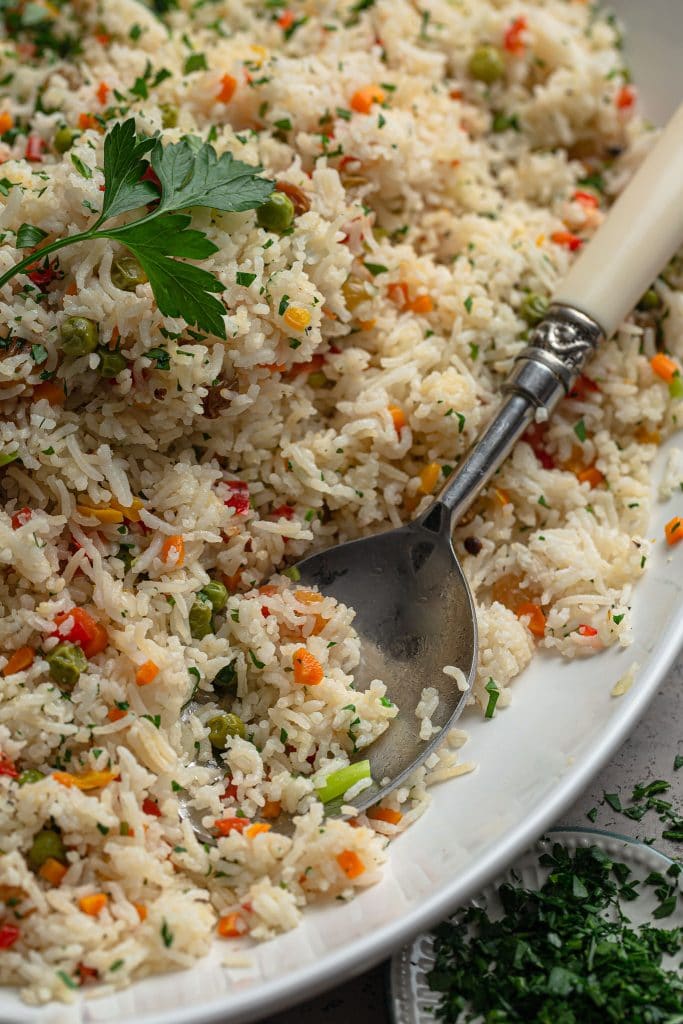
How to make Arroz a Grega
This rice pilaf is very easy to make! It takes just a little more prep work and sautéing then regular Brazilian rice, but it is so worth it.
If you’re strapped for time, you can use a bag of frozen veggies or a container of store-bought mirepoix, which will save you prep time.
As for the best pot for cooking rice, I am a big fan of using my Dutch Oven as it is very good at heating evenly and seals in moisture very well.
That is not the pot that is used in Brazil, mostly because Dutch Ovens are not popular down there! So if you don’t have one, you will be just fine using any large pot, like a stockpot.
Recommended tools and equipment: A fine mesh strainer or a rice washing bowl, and a Dutch Oven .
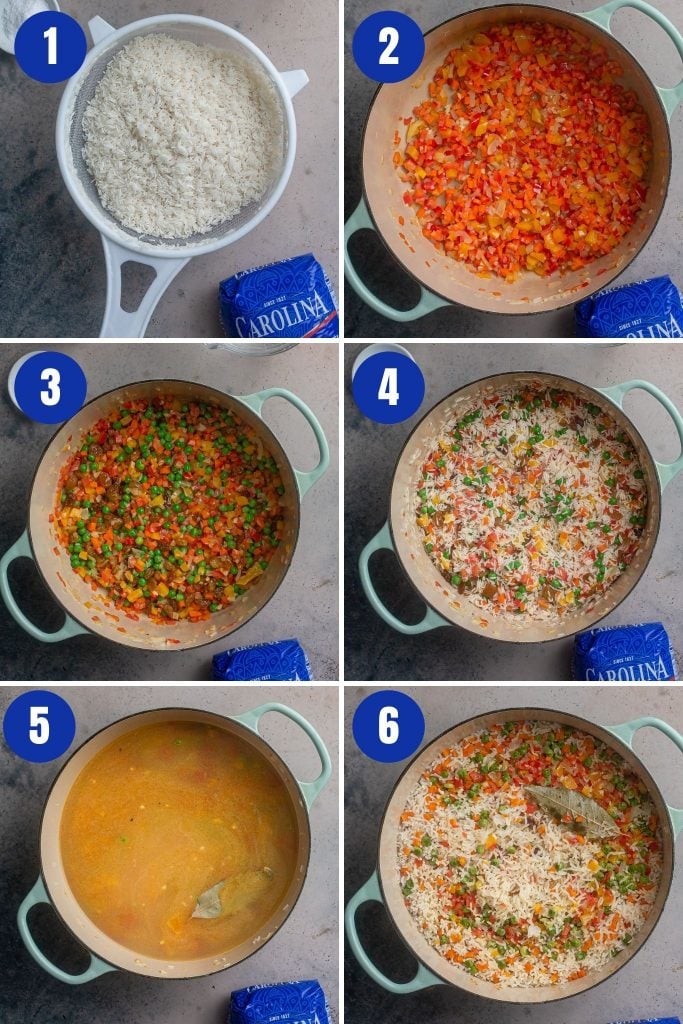
Here’s how I make Arroz à Grega. As always, you will find the printable (and more complete) version of the recipe at the end of this post!
Step 1: Rinse the rice.
- Place the rice in a strainer and rinse well, until the water runs clear. We want to get rid of all the extra starch so the rice grains don’t clump together and stay separated. (Photo 1)
Step 2: Sauté the veggies.
- Sauté the onion, carrots, bell peppers and garlic in the oil and butter. (Photo 2) I like to cook until the veggies are softened, even though they will cook and soften further with the rice, so they can develop more flavor.
- Stir in the peas and raisins, mixing to combine. (Photo 3)
Step 3: Cook the rice pilaf.
- Add the rinsed rice and season generously with salt and pepper. Let the rice sauté with the veggies for a couple minutes, so it can get coated with the oil. (Photo 4) That is another step to ensure it’s not sticky after it cooks.
- Pour in the hot water (doesn’t need to be boiling, just hot water from the sink is fine) and add a bay leaf if using. (Photo 5) I like to taste the water to see if it’s salty enough and adjust if needed.
- Cover and cook for 15 minutes, over low heat, until all the water has evaporated.
- Turn the heat off, crack the lid and let the rice rest for another 15 minutes. That will take care of any extra moisture.
- Fluff with a fork, then add the herbs and serve!
Olivia’s Tip:
After your rice has cooked for 15 minutes, you might open the lid to find that the grains are unevenly cooked: the top ones firmer and softer ones on the bottom. That is normal! You just need to let the rice rest, partially covered, so the moisture can redistribute.
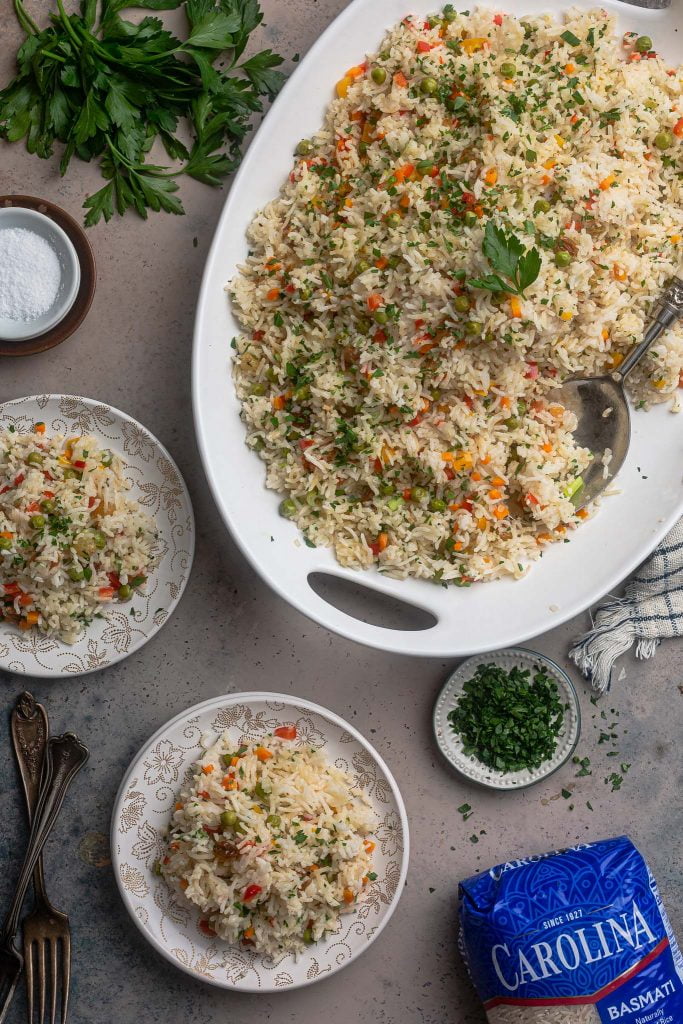
What to serve with Brazilian Greek Rice Pilaf?
Arroz a Grega is a very versatile side dish!
It goes great with holiday food, like turkey and/or roasts, but it also makes appearances in the summer, served as a side for grilled meat, chicken and fish!
This recipe can easily be doubled or tripled if you need to feed a big crowd.
Arroz a Grega Variations
This dish is the perfect vessel for whatever is sitting in your fridge, begging to be used before it’s too late!
Here are some suggestions:
- Omit the raisins or use another type of dried fruit, like currants or dried apricots, instead.
- No time for chopping vegetables? Use a frozen vegetable medley (carrots, corns and peas) instead.
- Use chicken or vegetable broth instead of water, for a boost of flavor.
- Add some protein. I’ve only seen Arroz à Grega made with diced ham, but you could also add shredded chicken or even bacon!
- Use brown rice instead of basmati. But be aware that you will need more water and that the rice will take longer to cook.
- Add corn (frozen, canned or fresh) or tomatoes.
- Top with toasted sliced almonds for some crunch! (But if you really love nuts, you might want to check out my Holiday Rice Pilaf with Almonds and Raisins.

Frequently Asked Questions
Yes! You can make it, let it cool and refrigerate for a couple of days before serving.
If reheating just a small portion, the microwave is fine. However, if you need to reheat the whole thing (or a substantial amount), my favorite way is using a double boiler.
If you don’t have a double boiler, set a saucepan full of water to boil, and then place a large bowl (larger than the saucepan) with the rice pilaf on it. Let it heat, stirring the rice every now and then, until hot!
This rice pilaf, when properly stored in an airtight container, will keep in the fridge for up to 4-5 days.
Yes, Brazilian Greek Rice Pilaf can be frozen! Just make sure to let it cool completely before transferring to an airtight freezer container or freezer bag. Then label and freeze for up to 3 months!
When ready to eat, thaw overnight in the fridge and reheat.
Did you make this recipe? I love hearing from you! Please comment and leave a 5-star rating below. You can also take a photo and tag me on Instagram with #oliviascuisine.

Arroz a Grega (Brazilian Greek Rice Pilaf)
Ingredients
- 2 cups [Carolina® Basmati Rice]
- 1 tablespoon vegetable oil
- 2 tablespoons unsalted butter
- 1 small onion, minced
- 1 large carrot, peeled and finely diced
- 1 red bell pepper, seeded and finely diced
- 1 yellow or orange bell pepper, seeded and finely diced
- 3 cloves garlic, minced
- 1 cup peas, frozen or fresh
- 1/2 cup golden raisins
- Salt and freshly ground pepper, to taste
- 3 cups hot water
- Optional: 1 bay leaf
- 1/3 cup chopped parsley
- 2 green onions, chopped
Instructions
- Place the rice in a fine mesh sieve and rinse until the water runs clear. Reserve to dry.
- In a large pot, over medium heat, heat the oil and butter. Once the butter has melted, add the onion and sauté for a couple minutes, until translucent. Then, add the carrot and bell peppers, and continue sautéing until they begin to soften, about 2-3 minutes. Stir in the garlic and cook for a minute, until fragrant.
- Add the the peas and raisins and mix to combine.
- Stir in the rice and sauté for a couple of minutes. Season with salt and pepper.
- Pour in the hot water and give it a good stir. Taste the water to check the seasoning and adjust as needed. Add the bay leaf, if using, and bring to a boil.
- Once boiling, lower the heat to a simmer, cover and cook for 15 minutes.
- Turn the heat off and crack the lid open. Let it sit, untouched, for another 15 minutes. Then, fluff with a fork and stir in the chopped herbs.
- Transfer to a nice platter and serve!



